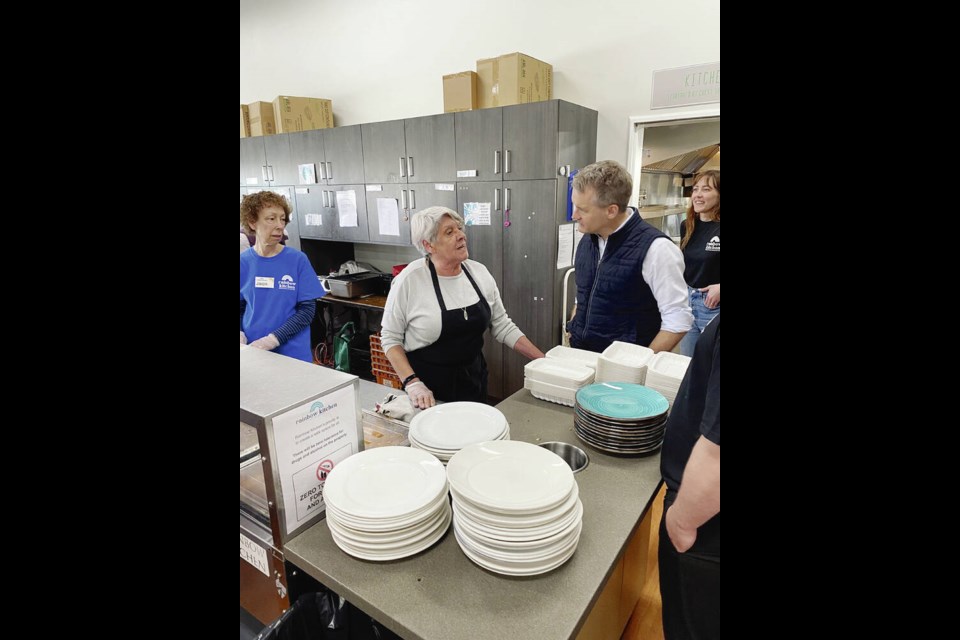Esquimalt’s Rainbow Kitchen is just the type of grassroots organization that will help make the new National School Food Program work, says the federal minister of labour and seniors.
“We are going to rely on organizations like this one, people who know their communities, people who know their schools,” said Seamus O’Regan, who was at the Lyall Street facility on Monday to promote the program, which will provide $1 billion over five years to help children across the country get enough to eat.
Announced in Toronto Monday by Prime Minister Justin Trudeau with Finance Minister Chrystia Freeland and Families Minister Jenna Sudds, the program is expected to provide meals to 400,000 more children a year, starting as early as the 2024-2025 school year.
The Rainbow Kitchen, which serves about 1,000 meals a day to those in need, has food programs at three nearby schools — Macaulay Elementary School, Rockheights Middle School and Esquimalt High School — with an eye to doing more, said executive director Patrick Johnstone.
“We have a list of schools who have seen what we can do and they want support from us,” he said. “It takes funding to get there.”
About one in four Canadian children don’t get enough food, according to federal government statistics, something school food programs have been trying to address for a long time.
“We still need it,” O’Regan said. “There are still children who go to school and don’t have the nutrition that they need.”
The new program is intended to fill the “gaps and holes” in the current system in partnership with provinces and territories, he said, adding that the need has become acute as food prices rise sharply.
Many provinces and territories are already providing their own programs alongside community groups.
In the past year, B.C., Manitoba and Nova Scotia have allocated money toward school lunches, but on-the-ground organizations have argued for a federal partner.
The Liberal government has long promised to launch a national school food program, and New Democrats have been pushing the Liberal government to fulfil that promise ahead of the federal budget, which Freeland is set to present on April 16.
The Rainbow Kitchen started out 14 years ago offering soup and sandwiches one day a week, Johnstone said. Now it provides 80 to 100 breakfasts and 250 to 300 lunches daily from Monday to Friday, and more people than ever before are bringing children in for meals.
“Seeing the children in here reminds us all that the need is huge, and the need is for all of us.”
Rachel Oelke, Rainbow Kitchen front of house manager, said pre-COVID there would occasionally be a family coming in, but now it’s common to see four or five a day.
Unlike at other similar agencies, children are allowed to eat at the Rainbow Kitchen, Johnstone said.
Pablo Avirri was enjoying Monday’s lunch with his three-year-old daughter Melissa — the menu featured pizza casserole, garlic bread and salad — and said they come to the Rainbow Kitchen every few weeks.
Along with the meal, he said we was planning on picking up a few of the onions set aside with other food items for diners to take with them.
He said he was happy to hear about the federal food program for schools, since many parents can use the support. “Now everything is so expensive.”
Serving up the food were volunteers like Giulia Collins, who said the Rainbow Kitchen is like a home away from home for her. “We have the most incredible guests,” Collins said. “The thing is our guests are so grateful that it makes it even better.”
She said the food program announced Monday is a step in the right direction. “When you think about children and they to go to school hungry, [with] an empty tummy, they can’t learn.”
According to Statistics Canada, 18 per cent of households in 2022 reported experiencing food insecurity during the previous 12 months.
The federal government offered few details on what a national school food program would look like and how federal funds would be allocated across the country.
Sudds said many of her provincial counterparts are thrilled about the prospect of the national program and are looking to the federal government for help to expand their own initiatives.
She also said the federal government is taking a flexible approach with the program so that it meets the diverse needs of different regions.
“The needs are different, certainly in different parts of the country. It may be breakfast, it may be lunch, it may be snacks,” Sudds said.
“We’ll look to our partners to engage in that dialogue as to what would be of best use in these unique circumstances.”
— With a file from The Canadian Press
>>> To comment on this article, write a letter to the editor: [email protected]



